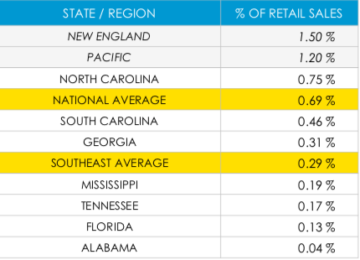Florida is set to establish energy efficiency goals for he state’s biggest power companies. This is a once in a five-year opportunity to reset and improve Florida's embarrassingly low energy efficiency performance – and the fate of programs that serve over 6 million families hangs in the balance.
George Cavros | September 25, 2019 | Energy Efficiency, Florida Right now, we have a once in a five-year opportunity to reset and improve Florida’s embarrassingly low energy efficiency performance. The state is almost at the bottom of state rankings in energy efficiency – totally slacking when it comes to helping families and businesses cut energy waste and save money on bills. Over 4,000 comments have been filed with the Florida Public Service Commission (PSC) from customers, as well as a dozen resolutions and letters from municipalities, urging meaningful goals be set for the state’s big power companies. Yet, many of Florida’s utilities are proposing goals of zero.
Right now, we have a once in a five-year opportunity to reset and improve Florida’s embarrassingly low energy efficiency performance. The state is almost at the bottom of state rankings in energy efficiency – totally slacking when it comes to helping families and businesses cut energy waste and save money on bills. Over 4,000 comments have been filed with the Florida Public Service Commission (PSC) from customers, as well as a dozen resolutions and letters from municipalities, urging meaningful goals be set for the state’s big power companies. Yet, many of Florida’s utilities are proposing goals of zero.
The Southern Alliance for Clean Energy and LULAC legal team has been challenging the power companies on this lackluster performance. We recently participated in a hearing before the PSC, and a few days ago we submitted our brief. The Commission is set to establish the goals on November 5th.
Here’s why the PSC decision matters
 Energy efficiency programs help hard-working families and businesses reduce energy use save money on bills. They also lower overall system costs – these are expenses that the utility would otherwise recover from all customers. Efficiency is also the quickest, cleanest, and most-cost-effective way to tackle climate change. Yet, the Florida utilities’ clearly don’t recognize these benefits, based on their sadly low goals.
Energy efficiency programs help hard-working families and businesses reduce energy use save money on bills. They also lower overall system costs – these are expenses that the utility would otherwise recover from all customers. Efficiency is also the quickest, cleanest, and most-cost-effective way to tackle climate change. Yet, the Florida utilities’ clearly don’t recognize these benefits, based on their sadly low goals.
JEA, Orlando Utilities Commission, Gulf Power Company have all proposed goals of zero energy savings over the next ten years. FPL has proposed virtually zero. The Florida Legislature never intended zero to be a goal. If the utilities’ proposed goals are approved, more than six million hard-working families would effectively lose access to utility-sponsored energy efficiency programs. This is unacceptable.
The fact that the utilities have proposed zero or near zero goals is a clear indication that the utilities’ way of determining “cost-effective” energy efficiency potential is outdated – in fact their methodologies date from 1994. The Rate Impact Measure (RIM) test used by the power companies, for example, measures your energy savings as a cost to the utility – thereby elevating the interest of utility shareholders over that of customers. If that sounds to you like a ridiculous antiquated test in setting goals, you’d be right.
It’s time to look at energy efficiency through a 21st century lens
 The utilities energy efficiency potential study is the epitome of the old adage, “garbage-in, garbage-out.” Southern Alliance for Clean Energy laid out in our brief reasonable, meaningful proposed goals for the utilities, and revealed the many ways the utilities put their “thumb on the scale” to get the outcomes they want – zero, or near zero goals. Some of the shenanigans include:
The utilities energy efficiency potential study is the epitome of the old adage, “garbage-in, garbage-out.” Southern Alliance for Clean Energy laid out in our brief reasonable, meaningful proposed goals for the utilities, and revealed the many ways the utilities put their “thumb on the scale” to get the outcomes they want – zero, or near zero goals. Some of the shenanigans include:
- The RIM test – no other state uses this outdated test in setting energy savings goals. The purpose of the test is to measure lost revenue to the utility from families and businesses saving money on bills through efficiency measures, like more efficient lighting. If the measure meaningfully saves energy, it is eliminated from the potential study. Is it any wonder many of the utilities ended up with a zero potential for energy efficiency?
- The 2-year payback screen – no other state uses this arbitrary method in setting goals. It eliminates measures that have a simple payback to the customer of 2 years or less – assuming that customers will adopt these measures on their own. Truth is, many customers don’t – especially hard-working families that may lack the information or financial resources to do so. By the way, the utilities already assume customers will adopt these measures and account for them in their demand (load) forecasts – so applying a 2-year screen is double counting.
- Absurd costs to administer programs – many Florida utilities set their administrative costs by the amount of energy an efficiency measure saves. Therefore, the more effective the measure is at helping customers save money on bills, the higher the administrative cost. This makes it more likely that low-cost, high-impact measures will be eliminated from the potential study.
Helpful, and not helpful briefs
In addition to the brief filed by SACE & LULAC, the brief filed by the Office of Public Counsel (OPC) helped set the stage for a positive outcome by arguing that the RIM test should no longer be relied upon as the sole test in establishing goals for Florida. Moreover, OPC stated the 2-year payback was not an appropriate methodology in setting goals.
Conversely, the unhelpful brief filed by the Florida Department of Agriculture and Consumer Services (FDACS) endorsed the utility goals and their flawed methodologies, and even called for the end of utility-sponsored programs. This is particularly stunning coming from an agency led by Commissioner Nikki Fried, who claims that consumer protection and climate action are a priority for her.
Heading toward a decision in November
The Commission is set to establish the goals on November 5th. Will Florida cement its place at the bottom of state rankings for helping customers reduce energy waste and saving money on bills? Will the Commission support the financial interests of the public, or that of big power company shareholders in setting goals? We can and must do better. Have your voice heard, file a comment with the Commission here.
Stay tuned, SACE will keep you updated as we head toward a November decision!